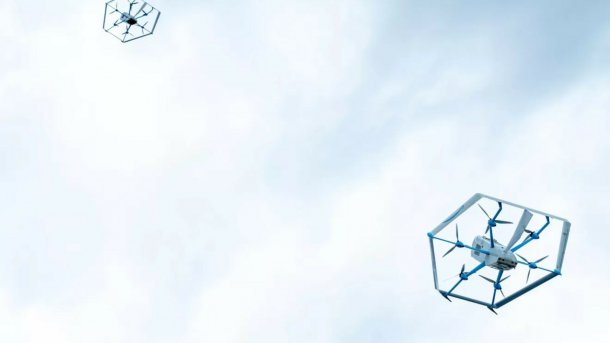Amazon Prime Air: Delivery drones cannot take off in high temperatures
Drones can react sensitively to different weather conditions. Amazon's delivery drones cannot cope with the high temperatures in Tolleson.

Two Amazon delivery drones fly to customers.
(Bild: Amazon Prime Air)
Amazon's planned drone delivery service in Tolleson near the city of Phoenix in the US state of Arizona has suffered a setback: The MK27-2 successor MK30 delivery drones to be used there cannot take off in temperatures above 40 degrees Celsius. This was reported by the US tech magazine Wired on Tuesday. This is a setback for Amazon, as the average daily temperatures there are higher than this for three months of the year. In cooler phases in the evening, however, the drones must also remain on the ground, as they are not allowed to be operated after sunset.
Amazon promised in April that the Prime Air drone delivery service would start in the West Valley of the Phoenix metro area in 2024. Goods are to be delivered within one hour of the order being received. The planned central Prime Air location in Tolleson was to be fully integrated into the delivery network at the time. This would be the first location to do so. The drones would then also fly to customers from smaller Amazon facilities around Tolleson, which are hybrid locations that are half fulfillment center and half delivery station, as well as from the headquarters in Tolleson, and deliver goods weighing less than 2.5 kg.
The preparations for this have already been largely completed. The only thing missing is approval from the US Federal Aviation Administration (FAA) and the local authorities. They have to decide whether the hexacopters, weighing around 40 kg, can take off and drop their load from several meters above gardens onto large mats marked with a QR code. The drones use the QR code to recognize the customer's drop-off point so that they can deliver goods safely.
Overheating problems
The project is now risking. This is because Amazon's new MK30 delivery drones have a problem in hot weather. If the outside temperature rises above 40 degrees Celsius, the motors and batteries are subjected to excessive thermal stress. They cannot dissipate the resulting heat sufficiently. Amazon had promised that the MK30 drone would cope better with different weather conditions than its predecessor. This is a problem at the Tolleson site, where average daytime temperatures exceed 40 degrees Celsius three months a year. It is also not possible to switch to the evening and night hours. For one thing, Amazon would then not be able to keep its promise of delivery within an hour if the order is placed during the day. Secondly, drones are currently not allowed to take off after sunset anyway.
This is a setback for Amazon's drone delivery service, which did not really want to take off at other Prime Air test locations anyway, unless the engineers can get the delivery drones' overheating problem under control.
(olb)